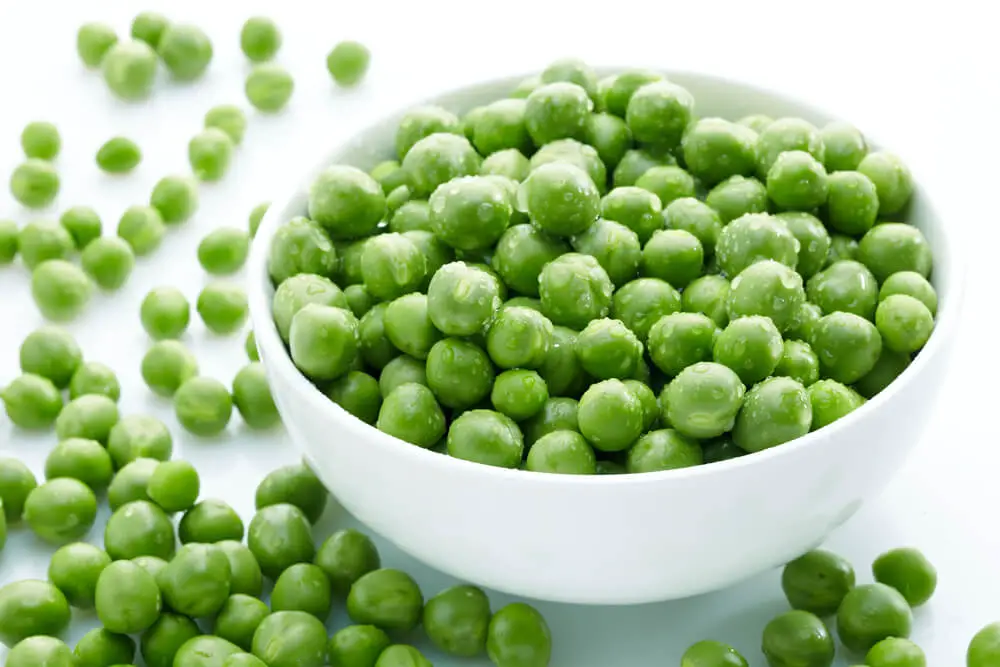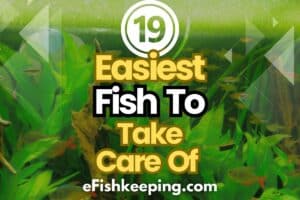Are you worried about your constipated fish refusing to eat peas? It can be frustrating to see your beloved aquatic pet suffering, and you may be wondering what to do next.
Keep reading to find out the possible causes and solutions for this issue, as well as alternatives.
Why Is Constipated Fish Not Eating Peas And How To Fix It?

#1. Some Fish Are Picky Eaters And May Not Like The Taste
It’s important to understand why your fish might be avoiding peas. Some fish are notorious for being picky eaters, and it’s possible that they simply don’t like the taste of peas.
SOLUTION:
Garlic is a great way to spice up your fish’s usual diet of peas. Fish are believed to be particularly attracted to garlic since it both attracts them and eliminates any off-putting scents.
The Sulphur component of garlic is likely the primary factor that draws fish to it.
Most fish species have an excellent sense of smell. They are able to distinguish between enticing and repulsive odors in the water because of their remarkable sense of smell.
Garlic is one of the most pungent odors, making it easily detectable by fish.
The alluring aroma of garlic travels fast through the water, is detected by the fish’s olfactory system, and is processed by their brain.
Garlic may be too strong of a flavor for certain fish, so don’t assume that all fish will like it. However, it is a good technique to mix garlic along with peas to get your constipated fish to eat the peas.
#2. Peas Are Not Given In The Right Way
Additionally, the texture of peas may be difficult for some fish to swallow. If you put whole peas inside the tank, then the fish will have a hard time consuming it.
If the peas are too cold or not mashed enough, your fish may not find them appetizing.
SOLUTION:
If your fish won’t eat peas, you can mash the peas into a softer consistency, which may make them more appealing to your fish.
Peas, in their full form, are too huge and difficult to digest for most fish, hence fish cannot consume them. Peas may be a healthy addition to a fish tank, but they should be processed first into a paste or finely chopped form.
#3. Peas Are Given At The Wrong Timing
Fish are more likely to eat when they are hungry, so if you are offering the peas at a time when your fish is not actively looking for food, they may be less likely to eat them.
SOLUTION:
Observe your fish’s feeding habits and try to determine when they are most actively looking for food.
This may vary depending on the type of fish you have. However, if you feed your fish at a particular time every day (like morning and evening), then they are more likely to eat during those periods.
If needed, you can also try skipping a meal to stimulate their appetite and then offering the peas in the next meal.
A hungry and opportunistic fish is more likely to consume any available food source.
#4. Fish Is In Stress And Experiencing Appetite Loss
If your fish is experiencing pain or discomfort due to constipation, they may not be interested in eating at all, regardless of the type of food being offered.
Also, the fish could be stressed by the environment. Fish are sensitive creatures and can be easily stressed by changes in their environment, such as a new tank mate or a sudden change in water temperature.
Stress can affect a fish’s appetite and make them less interested in eating.
SOLUTION:
To solve this issue, you can try the following:
- Create a calm and stable environment for your fish. Avoid making sudden changes to the tank, and try to keep the tank clean and well-maintained.
- Provide plenty of hiding places for your fish. Fish can feel more secure if they have places to retreat to, so adding plants, rocks, or other decorations can help to create a more comfortable environment for them.
- Try reducing the light in the tank. Fish are sensitive to light and may become stressed if they are exposed to bright light for too long.
The goal is to create a stress-free environment for your fish so that they can feel better and start eating the foods you offer them.
Does Peas Really Help With Fish Constipation And Swim Bladder Issue?
Peas are a natural source of fiber, which can help to ease constipation in fish.
So the next time your fish is experiencing digestive issues, don’t be afraid to try offering them some peas.
Just remember to mash or cook the peas to make them easier for your fish to consume, and offer them in moderation as part of a balanced diet.
Because green peas are so low in protein, they put less of a burden on the nitrogen cycle when fed to fish (since less ammonia is generated). Any fish in your tank ecosystem will benefit from reduced ammonia waste.
Green peas can assist with swim bladder issues since they sink when submerged in water.
As a result, the fish are forced to swim to the tank’s bottom while feeding, where they are less likely to swallow too much air and develop swim bladder disease.
How To Feed Peas To Treat Constipation In Fish?
Here are the steps for feeding peas to treat constipation in aquarium fish:
- Begin by thawing the frozen peas. You can either let them thaw at room temperature or run them under warm water to speed up the process.
- Remove the outer skin of the pea by gently squeezing it between your thumb and forefinger. This will reveal the soft, green inner part of the pea, which is more digestible for your fish.
- Cut the peas into small pieces, about the size of your fish’s eye. You can use a sharp knife or kitchen scissors to do this.
- Drop the pieces of peas in the fish tank and observe how the fish react to it. If they are eating – then it’s good. But if not then you can also mix garlic to make the meal more enticing for them.
- Don’t put excess peas and remove any leftovers to keep the water parameters in control.
Do Fish Like Eating Peas?
Plant-based diet is suitable for herbivores and omnivores, so it’s no surprise that peas are a great choice for these fishy friends. And even if your fish is a carnivore, like a betta, a few peas as an occasional treat shouldn’t cause any problems.
However, it’s important to keep in mind that every fish is different, and while some may devour peas, others may not be as interested.
If you’ve noticed that your fish are constipated and you’ve tried offering them peas as a solution, but it hasn’t worked, don’t worry!
There are other methods you can try to help relieve constipation in your fish. Don’t be afraid to experiment and find what works best for your finned companions.
Alternative Foods To Treat Fish Constipation
One alternative treatment option is to offer lettuce to your fish. Lettuce has fiber and contains laxative properties which can be helpful in curing constipation in your fish.
Here’s how to use lettuce as a treatment for your constipated fish:
- Wash the lettuce thoroughly. Rinse the lettuce under cold water to remove any dirt or pesticides that may be present. You can also boil it if needed to make the lettuce softer for the fish and also to remove any germs.
- Chop the lettuce into small pieces. Cut the lettuce into small, bite-sized pieces that your fish will be able to easily consume.
- Finally, offer the lettuce to your fish. Gently place the lettuce pieces into your tank and let your fish eat at their own pace.
If lettuce doesn’t work, then there are also vegetables to consider like Cucumber, Spinach, and Zucchini – all of which are rich in dietary fiber and helpful for curing fish constipation.
Symptoms To Know Fish Is Constipated
Here are some common symptoms to look for if you suspect your aquarium fish may be constipated:
- Stringy Poop: Fish that are constipated will often pass hard, stringy stool. Constipated fish poop will seem stringy and dangle off the fish, but normal fish poop will drop to the substrate right away.
- Swollen abdomen: A fish’s abdomen may appear swollen or distended if they are constipated.
- Decreased appetite: If your fish are turning down food or seem less interested in eating, this could be a sign that they are feeling unwell.
- Loss of energy: Constipation can be tiring for your fish, and they may seem less active or lethargic as a result.
Related Read: Why My Fish Keeps Swimming In Circles?
How To Know Fish Has Recovered From Constipation?
Here are a few signs that your fish may have recovered from constipation:
- Increased Appetite: If your fish are showing a renewed interest in food and are eating more normally, this is a good sign that they are feeling better.
- Normal Defecation: Keep an eye on your fish’s feces to make sure they are being produced in normal amounts and are of a normal consistency.
- Increased Energy: If your fish seem more active and energetic, this is a good indication that they are feeling better and have recovered from constipation.
Recommended Read: How Long Can Fish Live Without Oxygen?
How To Prevent Constipation In Fish?
Here are a few steps you can take to help prevent constipation in your aquarium fish:
- Feed a balanced diet: Make sure your fish are getting a varied diet that includes both plant-based and protein-rich foods. This will help ensure that they are getting all of the nutrients they need to stay healthy.
- Offer high-fiber foods: Feeding your fish high-fiber foods, such as peas, can help prevent constipation by keeping their digestive tracts moving.
- Avoid overfeeding: It’s important not to overfeed your fish, as this can lead to constipation and other health issues. Only give your fish as much food as they can eat in a few minutes, and remove any uneaten food to prevent it from decomposing in the tank.
It is important to regularly clean your fish tank to remove waste and uneaten food. Also, make sure to change the water and clean the gravel or substrate on a regular basis.
Suggested Read: How To Know If Fish Fin Rot Is Healing?
Wrapping Up
In short, if your constipated fish won’t eat peas, don’t worry. There are a few things you can try to get them to take the plunge, and there are also alternative food sources that are rich in fiber, as we shared in this post. Hope you found this guide helpful!
Hi! I’m Praveen Ghoshal, the founder of eFishkeeping.com. Inspired by my Dad, I got interested in fishkeeping when I was a kid. Since then, I have been involved with this hobby. Currently, I have 3 fish tanks at our home, and I enjoy this hobby with my full family. Read more about me here.







![Do Neon Tetras Die Easily? [Here’s The Truth!] do-neon-tetras-die-easily](https://efishkeeping.com/wp-content/uploads/2023/03/do-neon-tetras-die-easily-300x200.jpg)